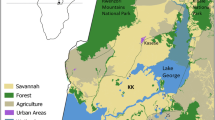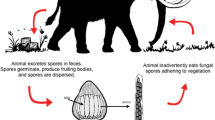Abstract
Decadal-scale analyses of fungal spores in a lake-sediment core from Ware Pond, located in the town of Marblehead in northeastern Massachusetts, test the potential of this approach for reconstructing past sheep and cattle grazing in southern New England, USA. The influx of spores of Sordaria and other coprophilous taxa increases at ad 1650, which corresponds with the beginning of European settlement, and subsequent peaks in these taxa at ad 1840 coincide with maximum abundances of weedy and agricultural taxa in the pollen record. Historical data from Marblehead and neighbouring towns indicate that maximum numbers of cattle and sheep occurred at this time. These findings suggest that fungal spores in New England lake sediments can be used to reconstruct changes in grazing pressure over time at the landscape scale.




Similar content being viewed by others
References
Anderson RS, Ejarque A, Rice J, Smith SJ, Lebow CG (2015) Historic and Holocene environmental change in the San Antonio Creek Basin, mid-coastal California. Quat Res 83:273–286
Baker AG, Bhagwat SA, Willis KJ (2013) Do dung fungal spores make a good proxy for past distribution of large herbivores? Quat Sci Rev 62:21–31
Brugam RB (1978) Human disturbance and the historical development of Linsley Pond. Ecology 59:19–36
Burney DA, Robinson GS, Burney LP (2003) Sporormiella and the late Holocene extinctions in Madagascar. Proc Natl Acad Sci USA 100:10,800–10,805
U.S. Coast and Geodetic Survey (1902) Beverly to Marblehead including Salem Massachusetts. Sheet No. T 2603. http://nosimagery.noaa.gov. Accessed 1 Dec 2015
U.S. Coast and Geodetic Survey (1919) Register No. 3766. http://nosimagery.noaa.gov. Accessed 1 Dec. 2015
U.S. Coast Survey (1850) Map of the N.W. shore of Mass. Bay from Saugus River to Marblehead. Sheet No. T 305-1. http://nosimagery.noaa.gov. Accessed 1 Dec 2015
Cogbill CV, Burk J, Motzkin G (2002) The forests of presettlement New England, USA: spatial and compositional patterns based on town proprietor surveys. J Biogeogr 29:1,279–1,304
Compton JE, Boone RD (2000) Long-term impacts of agriculture on soil carbon and nitrogen in New England forests. Ecology 81:2,314–2,330
Cugny C, Mazier F, Galop D (2010) Modern and fossil non-pollen palynomorphs from the Basque mountains (western Pyrenees, France): the use of coprophilous fungi to reconstruct pastoral activity. Veget Hist Archaeobot 19:391–408
Davis OK, Shafer DS (2006) Sporormiella fungal spores, a palynological means of detecting herbivore density. Palaeogeogr Palaeoclimatol Palaeoecol 237:40–50
Eberhardt R, Foster DR, Motzkin G, Hall B (2003) Conservation of changing landscapes: vegetation, land-use history, and fire on Cape Cod National Seashore. Ecol Appl 13:68–84
Ejarque A, Miras Y, Riera S (2011) Pollen and non-pollen palynomorph indicators of vegetation and highland grazing activities obtained from modern surface and dung datasets in the eastern Pyrenees. Rev Palaeobot Palynol 167:123–139
Fægri K, Iversen J (1989) In: Fægri K, Kaland PE, Krzywinski K (eds) Textbook of pollen analysis, 4th edn. Wiley, Chichester
Farrell M (2015) Later prehistoric vegetation dynamics and Bronze Age agriculture at Hobbister, Orkney, Scotland. Veget Hist Archaeobot 24:467–486
Feeser I, O’Connell M (2010) Late Holocene land-use and vegetation dynamics in an upland karst region based on pollen and coprophilous fungal spore analyses: an example from the Burren, western Ireland. Veget Hist Archaeobot 19:409–426
Foster DR (2002) Thoreau’s country: a historical-ecological perspective to conservation in the New England landscape. J Biogeogr 29:1,537–1,555
Foster D, Hall B, Burk J (2003) Massachusetts historical landcover and census data 1640–1999. Harv For Data Arch 40:3,557–3,569
Gill JL, Williams JW, Jackson ST, Lininger KB, Robinson GS (2009) Pleistocene megafaunal collapse, novel plant communities, and enhanced fire regimes in North America. Science 326:1,100–1,103
Gill JL, Williams JW, Jackson ST, Donnelly JP, Schellinger GC (2012) Climatic and megaherbivory controls on late-glacial vegetation dynamics: a new, high-resolution multi-proxy record from Silver Lake, Ohio. Quat Sci Rev 34:66–80
Hall B, Motzkin G, Foster DR, Syfert M, Burk J (2002) Three hundred years of forest and land-use change in Massachusetts, USA. J Biogeogr 29:1,319–1,335
Krug JC, Benny GL, Keller HW (2004) Coprophilous fungi. In: Mueller GM, Bills GF, Foster MS (eds) Biodiversity of fungi: inventory and monitoring methods. Elsevier Academic Press, Burlington, pp 467–499
MassGIS (2013) USGS color ortho imagery. Office of Geographic Information, MassIT, Commonwealth of Massachusetts
Miola A (2012) Tools for Non-Pollen Palynomorphs (NPPs) analysis: a list of Quaternary NPP types and reference literature in English language (1972–2011). Rev Palaeobot Palynol 186:142–161
Motzkin G, Foster DR, Allen AE, Harrod JC, Boone RD (1996) Controlling site to evaluate history: vegetation patterns of a New England sand plain. Ecol Monogr 66:345–365
Nationwide Environmental Title Research (2011) 1938 USGS aerial photo (1 November to 22 December 1938). http://www.historicaerials.com. Accessed 1 Dec 2015
Oswald WW, Foster DR (2011) A record of late-Holocene environmental change from southern New England, USA. Quat Res 76:314–318
Oswald WW, Faison EK, Foster DR, Doughty ED, Hall BR, Hansen BCS (2007) Post-glacial changes in spatial patterns of vegetation across southern New England. J Biogeogr 34:900–913
Parshall T, Foster DR (2002) Fire on the New England landscape: regional and temporal variation, cultural and environmental controls. J Biogeogr 29:1,305–1,317
Parshall T, Foster DR, Faison EK, MacDonald D, Hansen BCS (2003) Long-term history of vegetation and fire in pitch pine-oak forests on Cape Cod, Massachusetts. Ecology 84:736–738
Raper D, Bush M (2009) A test of Sporormiella representation as a predictor of megaherbivore presence and abundance. Quat Res 71:490–496
Raup HM (1966) The view from John Sanderson’s farm: a perspective for the use of the land. For Hist 10:2–11
Reimer PJ, Bard E, Bayliss A et al (2013) IntCal13 and Marine13 radiocarbon age calibration curves 0–50,000 years cal bp. Radiocarbon 55:1,869–1,887
Robinson GS, Burney LP, Burney DA (2005) Landscape paleoecology and megafaunal extinction in southeastern New York State. Ecol Monogr 75:295–315
Rule S, Brook BW, Haberle SG, Turney CSM, Kershaw AP, Johnson CN (2012) The aftermath of megafauna extinction: ecosystem transformation in Pleistocene Australia. Science 335:1,483–1,486
Stockmarr J (1971) Tablets with spores used in absolute pollen analysis. Pollen Spores 13:615–621
Thompson JR, Carpenter DN, Cogbill C, Foster DR (2013) Four centuries of change in northeastern United States forests. PLoS One 8:e72540. doi:10.1371/journal.pone.0072540
Van Geel B (1986) Application of fungal and algal remains and other microfossils in palynological analyses. In: Beglund BE (ed) Handbook of Holocene palaeoecology and palaeohydrology. Wiley, Chichester, pp 497–505
Van Geel B, Buurman J, Brinkkemper O, Schelvis J, Aptroot A, van Reenen G, Hakbijl T (2003) Environmental reconstruction of a Roman Period settlement site in Uitgeest (The Netherlands), w1ith special reference to coprophilous fungi. J Archaeol Sci 30:873–883
Van Geel B, Zazula GD, Schweger CE (2007) Spores of coprophilous fungi from under the Dawson tephra (25,300 C-14 years bp), Yukon Territory, northwestern Canada. Palaeogeogr Palaeoclimatol Palaeoecol 252:481–485
Van Geel B, Gelorini V, Lyaruu A et al (2011) Diversity and ecology of tropical African fungal spores from a 25,000-year palaeoenvironmental record in southeastern Kenya. Rev Palaeobot Palynol 164:174–190
Verheyen K, Honnay O, Motzkin G, Hermy M, Foster DR (2003) Response of forest plant species to land-use change: a life-history trait-based approach. J Ecol 91:563–577
Wood JR, Wilmshurst JM (2013) Accumulation rates or percentages? How to quantify Sporormiella and other coprophilous fungal spores to detect late Quaternary megafaunal extinction events. Quat Sci Rev 77:1–3
Wright HE Jr, Mann DH, Glaser PH (1984) Piston corers for peat and lake sediments. Ecology 65:657–659
Acknowledgments
We thank Jon Honea for field assistance. Bas van Geel, Michael O’Connell, and an anonymous referee provided constructive feedback that improved the manuscript. This research was funded by National Science Foundation grants DEB-1146207, DEB-1237491, and DBI-1459519.
Author information
Authors and Affiliations
Corresponding author
Additional information
Communicated by M. O'Connell.
Rights and permissions
About this article
Cite this article
Orbay-Cerrato, M.E., Oswald, W., Doughty, E.D. et al. Historic grazing in southern New England, USA, recorded by fungal spores in lake sediments. Veget Hist Archaeobot 26, 159–165 (2017). https://doi.org/10.1007/s00334-016-0577-8
Received:
Accepted:
Published:
Issue Date:
DOI: https://doi.org/10.1007/s00334-016-0577-8




